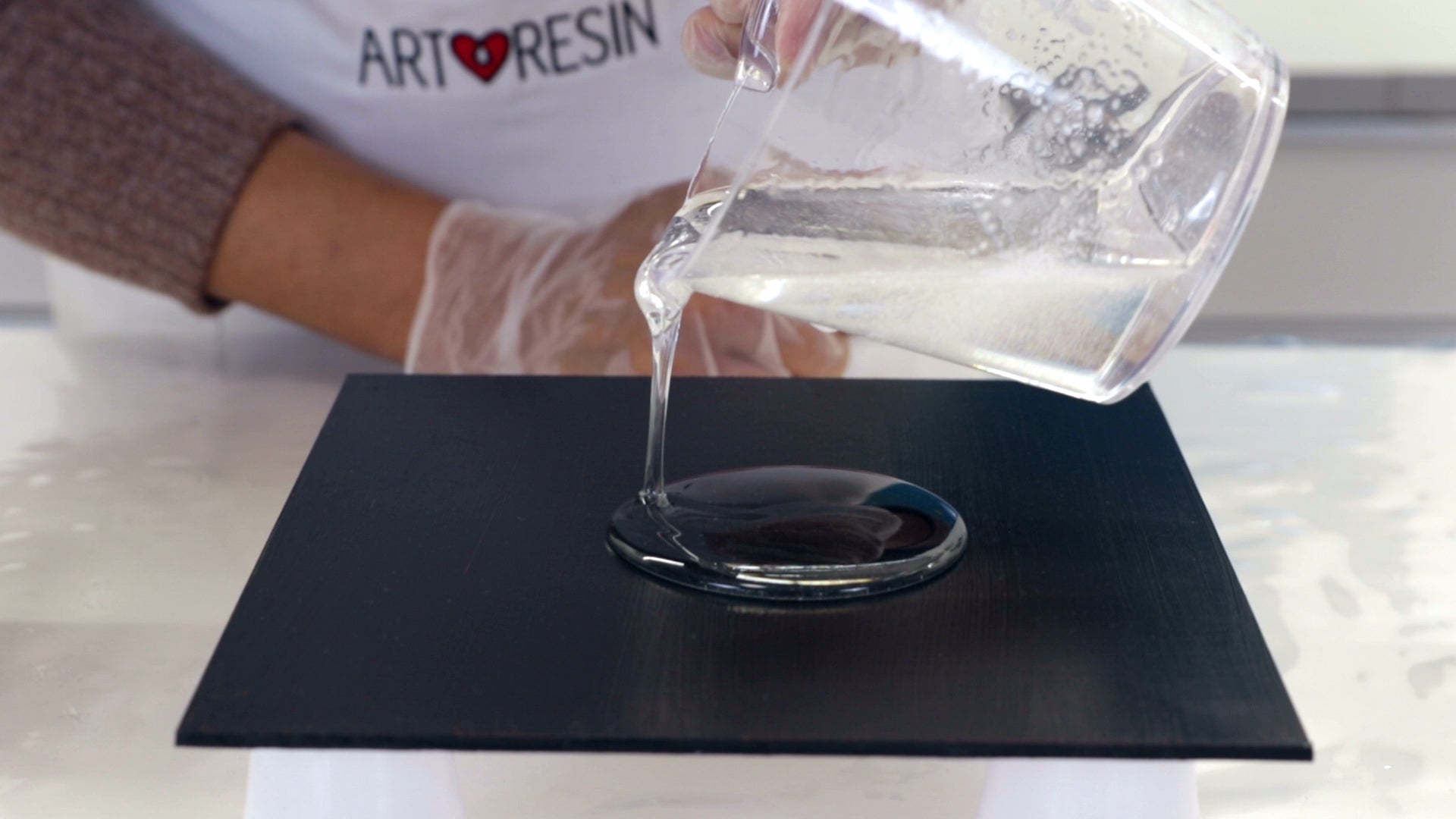Curing epoxy resin in cold weather can be challenging, as temperature is a key factor in how resin cures—and how well your project turns out. When temperatures drop below the ideal range, resin becomes thick and difficult to work with, resulting in delayed or incomplete curing, or even surface imperfections. If you're working with resin during winter or in colder environments, understanding these temperature effects and how to work around them will help your project turn out successfully.
What Is The Best Temperature For Curing Resin?
The best temperature for both your ArtResin and your workspace is slightly warmer than room temperature: 75-85°F or 24-30°C. Resin won't harden properly if the temperature is too low, so some precautions need to be taken during the cold winter months.
Why Temperature Matters for Resin Curing
Epoxy resin relies on a chemical reaction between the resin and hardener. This reaction generates heat, which allows the liquid resin to cure into a solid. This process is disrupted by cold temperatures, which slow down the chemical reaction. When the temperature drops below 72°F (22°C), you may encounter problems such as:
- Sticky or tacky resin: Cold weather can prevent resin from fully curing, resulting in sticky resin.
- Cloudiness and bubbles: Cold resin appears cloudy due to thousand of cold induced micro bubbles throughout the resin.
-
Longer curing times: The curing process may take much longer in cold conditions, sometimes up to several days.
Effects of Cold Weather on Resin
In colder weather, resin thickens up, making it difficult to mix and pour. Low temperatures also cause resin to take on a cloudy or milky appearance due to tiny air bubbles trapped within the liquid. These bubbles cannot be removed with a torch.
Cold conditions also interfere the resin's ability to self-level. Normally, resin flows smoothly across a surface, but in the cold, it struggles to spread, which can lead to uneven layers and imperfect finishes.
Tips for Curing Resin in Cold Weather
- The resin should be at room temperature: let it sit out for a few hours or give it a warm water bath.
- The workspace should be at room temperature: keep it no lower than 72°F/22°C and, ideally, above 75°F/24°C.
- The workspace should stay stable at room temperature for the first 24 hours of curing.
- Wondering why temperature is so important?
- What happens if you use cold resin?
- And what effect can a cold room have on your resin cure?
Let's find out ....
1. Ensure your resin is at room temperature.
Room temperature ArtResin epoxy resin is crystal clear with a honey-like consistency. On the other hand, cold resin is thick with a cloudy, milky appearance due to thousands of micro bubbles (that you'll never be able to torch out!)
Cold resin has a taffy like consistency, making it difficult to pour.

It will have a cloudy, milky appearance due to thousands of cold induced micro bubbles.

Cold resin is thick and difficult to spread.

It will not self-level as easily as room temperature resin and has a frothy looking appearance.

Even after torching, you will be left with frothy looking areas due to micro bubbles below the resin surface. You will not be able to torch these out.

How Can I Increase the Temperature of My Resin?
If your resin feels cold, you need to bring it up to room temperature before starting your project. Here's how to do it: You can do this by letting the resin bottles sit out to come up to temperature or you can try a warm water bath. Read our techniques below:
-
Warm the bottles before you measure and mix.
Let the resin bottles sit out to naturally reach room temperature or try a warm water bath.
- Use a warm water bath carefully:
- Warm the bottles BEFORE you measure and mix.
- Keep the bottle caps on tightly to prevent water from getting into the resin or hardener. Even a small amount of water can cause a cloudy cure.
- Place the bottles in a container of warm water. The water doesn't need to be very hot —think of the temperature you'd use for a baby’s bath.
- Don't submerge the bottles.
-
Allow the bottles to sit in the warm water for about 15 minutes (depending on how cold your resin was to start with and the size of your bottles.)
This simple prep step will help ensure your resin is ready to mix and pour smoothly, for the best possible results!

To prevent water from getting into your resin mixture, dry off the bottles thoroughly before you open them.
Resin that is at room temperature (or slightly warmer) is smooth, clear and with a beautiful honey-like consistency. It pours and spreads with ease.


💡TIP: If you’re warming your ArtResin with a water bath, be aware that heat promotes a faster cure: this means ArtResin's usual 40 minute working time will be shortened by about 10 minutes. It also means that if warmed resin is left sitting in the mixing cup on your work surface, the resin can heat up quickly, getting thicker and possibly even curing right in the cup. To avoid this, your artwork and supplies ready to go before you measure and mix the resin, and be sure to pour it right away. Don't leave warm resin sitting in the mixing cup!
2. Keep your workspace at room temperature or above:
When working with ArtResin, here are three key guidelines to maintain the right room conditions:
- WARM: 75-85°F (24-30°C) is ideal. Don't go below 72°F (22°C)
- DRY: 50% humidity is ideal. Anything below 85% relative humidity is acceptable
- STABLE: Keep the temperature consistent for the first 24hrs
During the cold winter months, try to plan ahead. Use a space heater to raise the room temperature, and allow your resin to sit in that room beforehand so it warms up too.
What Happens If The Room Temperature Is Too Cold?
If the room temperature is too low, resin can take much longer to cure. If it's below 72°F (22C), the resin may stay sticky for days or might not cure at all. In this case, try moving your piece to a warmer area or increasing the room temperature. If temperature was the issue, the resin should cure dry to the touch after 24 hours. 
💡TIP: If the resin is still sticky after 24 hrs in a warmer environment, a measuring or mixing issue is likely the cause. Check out our blog for tips on fixing sticky epoxy resin.
3. Keep the resin room at a stable temperature for the first 24 hours.
The first 24 hours of curing are crucial—the room should stay warm, dry, and stable, without any temperature dips or fluctuations.
For example, curing your freshly resined piece to cure in a sunny window seems ideal. However, when night falls and the temperature does too, you may end up with the "orange peel" effect. This may look like dimples in your resin, waves and other strange surface imperfections.
This piece was done in winter and allowed to cure in a sunny window. When the sun went down, the temperature plummeted and the piece cured with dimples and other imperfections.

This piece was resined in November at the start of Canadian winter. It cured in the warm ArtResin studio at 75°F/24°C for 2 hours. It was then moved to the garage where daytime temperatures were just above freezing and below freezing at night. By morning, it was dry to the touch but covered in imperfections.
This piece cured in the warm studio for about 5 hours and was moved to the cold garage to complete its cure: it also cured with surface imperfections.
This piece cured in the warm studio for 8 hours before finishing its overnight cure in the garage. It’s in better shape than the first two boards, but there are still noticeable imperfections.
You can clearly see how temperature drops midway through curing create wavy, streaky, dimpled, and uneven surfaces.
Luckily, this is an easy fix!
Check out our blog post, How To Apply A Second Coat, to learn how to fix surface imperfections.
Common Mistakes When Curing Resin in Cold Weather
1. Skipping the Warming Step
One common mistakes is not bringing the resin and hardener to room temperature or warmer before use. Cold resin is hard to work with and won’t spread evenly, leading to an improper cure or imperfect finish.
2. Allowing the Room To Get Cold Overnight
Temperature drops during curing can create surface imperfections. Be sure to maintain a warm, dry, stable environment for the first 24 hours.
3. Not Using a Heater in Cold Conditions
Working in a cold garage or basement without any added heat is a recipe for trouble. Resin needs a warm environment to properly cure, so if it’s too cold, your project may end up sticky, full of bubbles, or with surface imperfections.
Remember, when working with ArtResin epoxy resin:
- Use resin that’s at room temperature.
- Keep your workspace at room temperature or warmer. 75-85°F (24-30°C) is ideal.
- Maintain a stable room temperature for the first 24 hours of curing.
Following these simple steps will help ensure a flawless ArtResin cure, ust like this piece below:

What is the best temperature to store ArtResin epoxy resin?
Opened or unopened, store your ArtResin bottles in a dark spot, out of direct sunlight and in a spot where the temperature will stay stable at room temperature or just slightly below (70F or 20C).
Want to learn more about ArtResin epoxy resin? Check out our helpful guides below:
- Does ArtResin Expire?
- What's The Cure Time Of Epoxy Resin?
- Does Epoxy Resin Shrink?
- What Happens If Epoxy Resin Freezes?
- How Long Does Epoxy Resin Last?
- Does Epoxy Resin Crack?
- Is Epoxy Resin Self-Leveling?
- What's The Working Time of ArtResin?
- Does ArtResin Smell?
- Is Epoxy Resin Waterproof?
- Types of Epoxy Resin & Their Uses
- How Does Moisture Affect Epoxy Resin?
- How Does Hot Weather Affect Epoxy Resin?
Hope this was helpful!
Please leave any questions or comments below.
ArtResin: The Original Epoxy For Resin Art.


